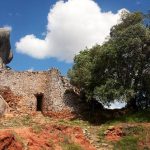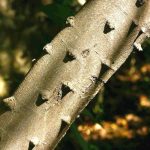TREE LIFE
March 1986
MASHONALAND CALENDAR
Tuesday 4th March: Botanic Garden Walk, meet at 1645 hours for 1700 hours at the car park. We have arranged with Tom Muller for the Garden’s security guard to look after the cars.
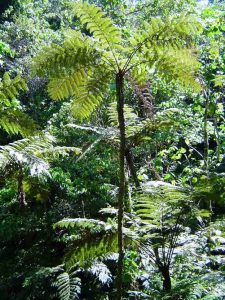
Chyathea manniana. Photo: Bart Wursten. Source: Flora of Zimbabwe
Sunday 16th March : AGM at Gletwyn : The 36th AGM of the Tree Society of Zimbabwe is to be held at 0930 hours at Gletwyn, the home of Ian and Biddie Ross. Please forward nominations for positions on the committee, either in writing or by phoning any of the current committee members. This is also an earnest call for anyone who would like to serve on the committee, please don’t be shy to let us know, having an enthusiastic and active committee really does ease the burden quite considerably. This is your society so please help. Afterwards we will have lunch and roam through fine woodland to a patch of Syzygium forest with a difference. To prepare ensure that you know the difference between Chyathea manniana and C.dregei. And if you thought the AGM was in Manicaland you are wrong, its practically inside Harare. As it is so close we will not meet at Monomatapa but anyone who cannot organize a lift please contact Phil Haxen or myself Kim, at 8871413. This is the AGM so let’s really make an effort.
11 – 14 April : Mana Pools
It is some time ago since we announced this trip and people’s plans may have changed. Please send your cheque for $225 to cover the deposit. If you have already paid please confirm that you still wish to be included. If numbers are such that there are too many people and you are not able to be included, your cheque will be refunded immediately.
Transport to Mana has still to e arranged and the cost will be in addition to the $225. Cheques and confirmation to Meg Coates Palgrave, PO. Box 4643, Harare, or 12 Kariba Crescent, Hillside, Harare. Telephone 84419.
1st – 4th May – Matopos
Meeting up with members of the Matabeleland Branch. Transport and accommodation to bearranged by members themselves. National Parks have lodges and chalets and caravan and camp sites are available.
Thursday May 1st is a public holiday. The plan is to travel to the Matopos in the morning, spend the afternoon in the vicinity of Maleme Dam. Venues for Friday and Saturday will be arranged by the Matabeleland Branch. We hope this will include a full day in the Matopos and a day in a Kalahari sand area but the final choice will be left to them. Return home on Sunday with a not too early start to give us time for a bit of botanizing in the morning.
If you are able to arrange accommodation and transport and join the trip please contact Meg Coates Palgrave, 12 Kariba crescent, Hillside, Telephone 84419 so that we can make arrangements for communal catering.
MATABELELAND CALENDAR
Sunday 2nd March : We will go to Mabukuweni. Meet there at 0830 hours.
On Sunday February 2nd we went to the Matopos, firstly to an area just off the Cyrene Road, then in stages, from the old Railway Terminus, along the Scenic Drive, to the start of the Honeyguide Highway.
We first looked at a group of Acacia tortilis, not common here, and then on to a somewhat dry, rocky kopje, however, with indications of recent rain, off the Cyrene road. Here we identified some 55 trees, some a bit stunted, owing no doubt, to the stony habitat – Acacia fleckii, A.gerrardii, A.goetzii, this is uncommon here, A.karroo, A.rehmanniana, A.robusta, Azanza garckeana, flowering Bolusanthus speciosus, Burkea africana, Carissa bispinosa, Carissa edulis, Cassine matbelica and Cassine transvaalensis, Clerodendrum glabrum and C.myricoides; on the top of the kopje Commiphora schimperi seemed dominant, with also Commiphora africana, C.pyracanthoides, even a few C.mollis; we also saw Ehretia rigida, Erythrina latissima, with young growth incredibly prickly, no doubt as a deterrent to grazers; Euclea divinorum, Euphorbia ingens, Grewia flava, Grewia flavescens and Grewia monticola, Heterophyxis dehniae, Lannea discolor, Olea europea subsp. africana, Ozoroa insignis subsp. reiculata, Pappea capensis, Rhus lancea, Rhus lancea, Rhus pyroides and Rhus tenuinervis, Schlerocarya birrea, Turrea nilotica, and Ximenia caffra. We then drove on to the Old Railway terminus, followed by the Scenic Drive, stopping in various places as we went, for further identification. We added to our list some 30 trees including Acacia galpinii, Allophylus africanus, Aloe excela, Brachystegia spiciformis, these only occur in a few patches in the Matopos and not in Bulawayo district, so are something of a “treat”. Cordia grandicalyx, Crossopteryx febrifuga, this was growing alongside an unusually tall Turraea nilotica of about 6 meters, Cussonia arborea, Diospyros mespiliformis, Euphorbia cooperi, Gardenia volkensii, Homalium dentatum, flowering heavily, but unfortunately with a clear bole for some meters, preventing us from studying the leaves, Kirkia acuminata, Mundulea sericea, Ochna glauca, Ptaeroxylon obliquum, Pterocarpus angolensis and Pterocarpus rotundifolius, Pterolobim stellatum, Sesbania sesban and Zanthoxylum capensis.
An excellent day, due greatly to our guide, Geoff Archer.
-C.Sykes
BOTANIC GARDEN WALK, FEBRUARY 1986 : THE HOOKERS
Most of us are somewhat nervous when first faced with a hooker, but on this occasion we gained much confidence from Tom’s intimate knowledge of this damnable group – the hook thorn Acacia species. In Zimbabwe a tree with bi-compound leaves leads us straight to the legumes, and generally to the MIMOSACEAE in particular, there are also a few in the CAESALPINIACEAE. Bi-compound leaves and hooked thorns is invariably an Acacia, with two important exceptions : firstly the introduced Mauritous thorn, Caesalpinia decapetala, a plant we know from Binga Swamp Forest. Secondly Albizia harveyi in which the old leaf scar may develop into a single sharp hook.
The genus Acacia is divided up n whether the flowers are in a round pom-[pm, in which case the seeds are clustered from a single point,, or on an cylindrical spike, leading to seeds on an elongated stalk;. But as these natural features are temporal, we will divide them into four artificial groups based on spine structure;
- Prickles scattered, flowers in pom pom or cylinder
- Hooked prickles in pairs, or 3’s, flowers in cylinder
- Hooked prickles and straight spines, flowers in pom pom
- Straight spines in pairs, flowers in pom pom.
There is only one important exception to all of these groups, Acacia albida. These differences are so striking it is sometimes placed in a different genus : Faidherbia albida. It bears the most unusual combination of cylindrical flowers and pairs of straight thorns. Another strange feature was illustrated in Tom’s two large specimens they were totally leafless and remain so throughout the rainy season. They flower and bear leaves in winter completing fruit development before the rains. The sight of these trees in grey foliage and dropping the large contorted “apple peel” pods is familiar to anyone who has visited the Zambezi Valley in august or September. It is almost a standard joke to watch new visitors pitch tents beneath an A.albida and wait until the elephants come nosing around calmly seeking the pods, oblivious of the latest intruders who sit nervously in deck chairs a few feet away Bearing leaves in the dry season is possibly related to their flood plain situation where summer water logging is common Water logging starves the roots of their air supply and inhibits growth. Strangely its ability to withstand flooding also seems to allow it to survive drought. A similar effect is seen in Gardenia volkensii which is drought resistant yet may have its feet in water. Acacia albida has been widely marketed as an idea local candidate for agro-forestry projects in view of the winter shade, nitrogen fixation and summer leaflessness, The wood is tough and hard, but not very durable. Unlike many other acacia species, A.albida has no gland on the petiole, instead it has a gland between each pair of pinnae as in Newtonia.
Group 1 : Scattered Prickles – 6 species
The six indigenous species with scattered, hooked prickles seldom grown into large trees, two are really overgrown scramblers. We were fortunate enough to find most of them in flower. Half of them have cylindrical flowers, A.ataxacantha, A.chariesea and A.eriocarpa, the other half have pom poms, A.schweinfurthiana, Aabenocalyx and A.pentagona. The stems of some species, A.ataxacantha, A.schweinfurthiana and A.pentagona have their prickles arranged along dark lines down the stem.
We began with the A.pentagona scrambling around beneath the Melicia, Chlorophora. This species is a vigorous scrambler in the moist rain forests of Manicaland. In all Tom’s specimens the petiolar gland is brown, resembling a small flour beetle. In contrast the petiolar gland of the A.ataxacantha we saw in the Acacia section was green and resembled a large caterpillar with its head raised in an alarm posture. This species climbs through jesse bush on deep sands in the Zambezi Valley. A.ataxacantha has large shield like stipules that are different to the small stipules on A.schweinfurthiana. Tom’s A.schweinfurthiana, near the Albizia versicolor, really has taken off growing into a pruner’s nightmare. This species often grows on termite mounds or associated with riverine areas the round petiolar gland is smaller than that of A.ataxacantha.
Between the A.ataxacantha and St. George’s we found two other species with scattered thorns, on this side of the road was a flowering A.eriocarpa. Unlike the scrambling species, this species forms a small tree and has larger leaflets as well as golden hairs on the leaf rachis and young branches. It has a scattered distribution in Hwange and the Valley. Just over the road and among some rocks was a small A.adenocalyx looking similar to A.shweinfurthians but with blackish twigs. This specimen was collected by Tom from the Mudze area in the north east.
Heading towards the Combretum section we found A.cariessa. Tom has had great difficulty growing these and is trying to recreate the small thickets one finds in the bush, particularly in mopane woodlands and in Acacia bush between Gweru and Bulawayo. The leaflets are very fine and the petiolar gland is often absent.
Group 2 : Paired, hooked prickles, cylindrical flowers – 9 species
In those species with long straight spines, those spines are really modified stipules. The pair of hooked prickles are not modified stipules and so in these species the small stipules may be seen in addition to the prickles, although they often fall off very early.
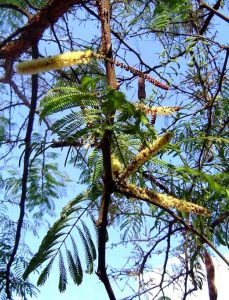
Acacia galpinii. Photo; Bart Wursten. Source: Flora of Zimbabwe
One species in group 2 has prickles in 3’s, A.senegal, the rest may be arranged in a series from those with many small leaflets to those with few large leaflets. This series is, A.polyacantha, A.galpinii, A.fleckii, A.erubescens, (A.burkei, A.welwitschii and A.goetzei) and A.nigrescens. We looked at 5 of these.
A.polyacantha has more and much small leaflets than all the rest and so is not a problem. We saw how Tom’s tree had developed bosses on the pale flaking trunk. This trunk is readily identified from a distance and the sight of the grove of A.polyacantha below Maowe Dam wall when in full flower is a spectacular sight. This species is often seen I groups in semi vlei areas.
The small A.galpinii near the Cordyla demonstrated the hooked thorns well and also showed the typical juvenile growth of many Acacia species. Initially they form bushy shrubs with no obvious trunk and improve their root system. Then all of a sudden one strong shoot emerges at a diagonal and takes over, giving structure and form to the tree. Cheryl’s A.polyacantha sat on the ground for three years before growing six feet in one season. In order to speed growth one can trim them down to one stem, but then this usually needs to be staked and we prefer to leave them. The large A.galpinii alongside the A.polyacantha in the gardens demonstrated how it is often more difficult to find thorns on big trees A.galpinii has many leaflets and as there is a big jump to A.fleckii this does help.
A.fleckii and A. erubescens are often confused as they both have flaking bark and grow in the south and west of Zimbabwe. In A.fleckii the petiole is shorter than 1cm and the length of the two longest pinnae is less than that of the rachis. In A.erubescens the petiole is longer than 1cm and the length of the two longest pinnae is greater than that of the rachis. We saw a bushy A.erubescens alongside the tall A.galpinii and found A.fleckii closer to the S.E. lowveld section between S.schweinfurthiana and A.ataxacantha.
We had also briefly examined the knob-thorn A.nigrescens with only one pair of leaflets on each pinna – the lowest number in the complete series. We will examine the rest sometime later. Thanks Tom, we will try to work on them in future.
-Kim ST.J.Damstra
VISIT TO THETFORD, MAZOWE 16TH FEBRUARY 1986
We had a warm but cloudy for our visit to Thetford and although a misty blue haze hung over the far reaches of the dam and surrounding hills it only enhanced our enjoyment of the occasion. The striking beauty of Thetford house, the spectacular view across the Mazowe lake to the wall in the far distance and lush vegetation, trees in particular, all made it a visit to remember.
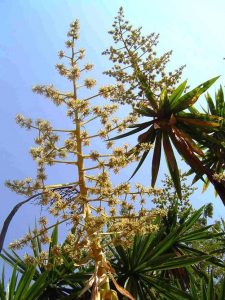
Draecaena steudnerii. Photo: Mark Hyde. Source: Flora of Zimbabwe
After tea, partaken by all around one of the verandahs, we divided into two groups, mine being squired by Phil who wasted no time by immediately pointing out the young Schotia brachypetala planted in the garden, a large Draecaena steudnerii and before proceeding out through the security gate, Pterocarpus angolensis, Brachystegia boehmii as well as a particularly fine, graceful Brachystegia glaucescens with its smooth grey bark.
I counted 56 trees from my notes on the morning walk and here are those I think most memorable.
Phil spent a few moments explaining some of the differences between Albizia antunesiana and Burkea africana which are often found growing close together and which beginners often confuse. This Albizia has opposite leaflets which are often purple coloured when young as opposed to the alternate leaflets of Burkea which also has rust coloured velvety tips to the branches.
Some of us walked around with the hairy textured leaf of the Puzolzia mixta, P.hypoleuca, stuck to our blouses and Indigofera rhynocarpa became a familiar sight with its recognizable hockey stick fruits. Hexalobus monopetalus, baboon’s breakfast, with its peanut like fruit provided us with food for thought, as well as Flacourtia indica bearing its characteristic pink new leaves with serrated edges and we even found a spine or two on trunk and branches.
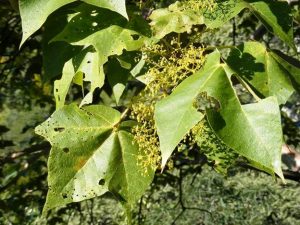
Sterculia quinqueloba. Photo: Mike Bingham. Source: Flora of Zimbabwe
I thought the most striking tree seen on this outing was quite definitely the Sterculia quinqueloba. Its large greenish yellow five lobed leaves looked almost luminous as the crowded the ends of the branches together with sprays of flowers in bud which had the appearance of young bunches of grapes, the whole of which contrasted strongly with the pinkish brown smooth rather satiny looking bark and gave it an almost fairly tale quality. Named after Sterculius, the Roman God of privies and manuring, because the leaves of some species are inclined to smell although there was no suggestion of this on our very handsome find.
I found myself taking a greater interest in tree trunks, branches and barks on this walk, finding quite a wide variation from the smooth Sterculia with its undulating almost languid movement to the gnarled, curiously twisted shapes of the Diospyros kirkii.
An oft occurring tree was Monotes engleri, bearing leaves with grayish silvery hairs beneath as distinct from the smooth glossy yellow green leaves of the Monotes glaber. It was interesting to hear the Lannea discolor referred to as ET fingers which is very apt because of the spiky finger like appearance of the branchlets. Often known as the never die or livelong tree, it is said to be the first to get its leaves and last to lose them. The leaves are compound, light underneath and dark on the surface.
We saw the distinctive feature of hairy armpits on the leaves of a huge Allophylys africana growing atop an anthill. Dick Petheram remarked that one could be forgiven for thinking something was about to emerge from those hairs. We were lucky to find a Bridelia cathartica with tiny individual star-like flowers running along the stems right alongside some with the familiar tell tale scars and fragments of flowers we most often see.
A stop was made at jutting outcrop of granite rock and while catching a breath and admiring the magnificent view across the Mazowe Dam we found Ficus salicifolia just below us. This species has rather leathery leaves with basal veins that look like curved bulls horns and small ink, wart like fruit in the axils of the leaves. A white flowering orchid, Habenaria stylites var. rhodesiaca was found and much admired and as we moved away a pair of Wahlberg’s eagles was seen silently gliding and wheeling around only a few meters overhead.
Another interesting find must have been the sole Ochna gambleoides which is widespread but never common, with its blue green rounder leaves by comparison with those of Ochna schweinfurthiana which are narrower with sharply serrated margins and yellow green in colour. Also not seen often, last seen on our visit to New Erewhon at Arcturus, was Philippia benguelensis. Of personal enjoyment was encountering Heterophyxis dehniae, lavender tree, with its dark shiny green leaves which exude the lovely aroma of lavender from which it obviously gets its name. We are also most grateful to Jacquie Narracott for having the path slashed, the walk was indeed rewarding, both botanically and aesthetically.
-Marjorie Barker
After lunch we bade farewell to our hosts Mr. and Mrs. Narracott and drove down the winding drive to the river so that we could walk along the banks. The first tree of note was the Securidaca longepedunculata or violet tree known for its very toxic properties severe enough to cause death. The next tee to catch the eye was the large Terminalia sericea or yellow wood which is termite resistant so can be put to good use for fencing jobs, tool handles, hut poles. Nearby was the Monotes glaber with its lovely shiny green leaves showing the small gland at the base of the leaf blade. Further along we saw the Pterocarpus rotundifolius showing off attractive trifoliate leaves. As we approached the confluence of this tributary with the Mazowe River we saw the effects of the flood waters a week previously when an upstream farm dam had burst. The waters had rushed 6m over the bridge and swelled to about 100m in places. Numerous trees had been upturned and others bent over. Most surprising was the fact that many had already readjusted to their new positions and a number of Acacia sieberana and Combretum erythrophyllum had already sent 10cm long new shoots vertically upwards. Along the banks of the Mazowe we found a large Kigelia africana with its hard textured leaflets. Soon afterwards we saw Zizyphus mucronata with its rough fissured bark so characteristic of this tree. Before our return we noted the Diospyros lycioides, red star apple, and we paid particular attention to the veining of the leaves.
So ended a very pleasant day with excellent views and very attractive countryside.
-Margaret Bennett
THEDFORD – continued
On Sunday afternoon, having made a late start from the homestead because we thought it best to nurse our ailing car along without danger of holding up a stream of traffic behind us Edone and I became separated from the rest of the party and stopped at the drift to have a look around.
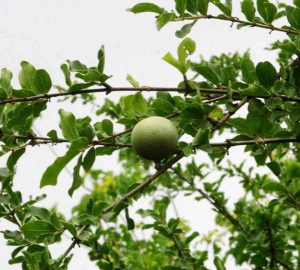
Strychnos madagascariensis. Photo: Bart Wursten. Source: Flora of Zimbabwe
Our first pause though was immediately outside the homestead gate, where we plucked a little foliage from a Strychnos madagascariensis. It was a foregone conclusion that by the time it reached the Herbarium, it would have been transformed into Strychnos innocua. It never fails. Had we found what we assumed to be S.innocua, it would almost inevitably have proved to be S.madagascariensis!!
At the river we were appalled at the devastation caused by the recent flood from rains or burst spillway. We could have begun a thesis on root formation of uprooted trees, mostly mixed combretums. We were more interested, though, in looking at standing species than at reclining ones, and this we did within a 30 to 40m strip on the right bank of the river, and for a distance of a mere 250m downstream from the drift. A very short ramble but we took our time over it
What needs saying first is that, to compensate for flood casualties, there were more river combretum, Comretum erythrophyllum, growing in splendid profusion. The excitingly unexpected find of a river combretum growing from a crevice near the top of the kopje in the morning, many hundreds of feet higher up, was also noteworthy.
Notable in terms of numbers, also were Celtis fricana, Pittosporum viridiflorum, Diospyros lycioides and Rhus longipes. Vangueria randii and Allophyllus africanus mingled with them So did Euclea divinorum Cascia salicifolia and the “snowberry” Securinega virosa.
At the drift there were remnants of Salix subserrata which must have ducked when the flood thundered past. There would almost certainly have been an abundant downstream colony of these little willows but for the flood, interspersed perhaps with the rough leaved Ficus capreifolia and Acokanthera oppositifolia which one sort of feels should be around in those parts, and possibly Teclea rogersii which I seem to remember is endemic to the Mazowe. We looked, unsuccessfully, for Ilex mitis and Linociera battiscombei. We found a solitary specimen of Mimusops zeyheri, Strychnos potatorum, Flacourtia indica and Zanha africana, all small. We did not see the parent trees on our beat.
A species of note was Olea europaea. It looked familiar. We knew we should know it. Took a specimen and peered at it again the next day, uncomprehendingly. Mr. Drummond was considerate enough to say, later, that it looked rather like coppice growth, to temper the embarrassment of my having to return home from the Herbarium to study the Olea we have had growing next to the drive way for at least 10 years.
-R.W.Petheram
KIM DAMSTRA, Acting Chairman


